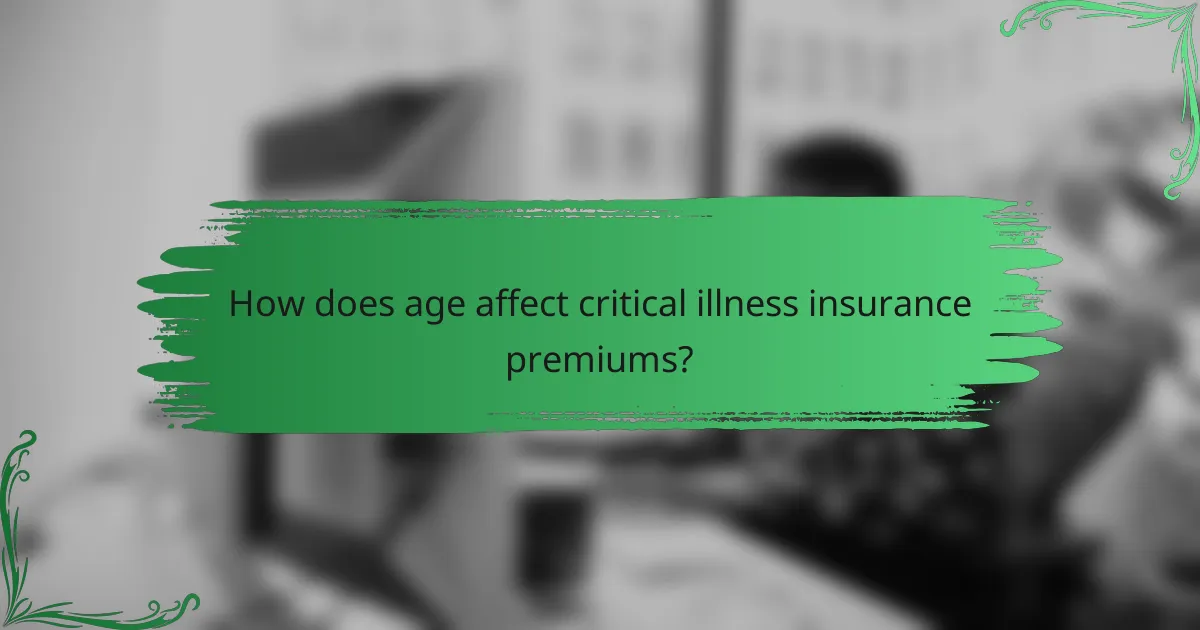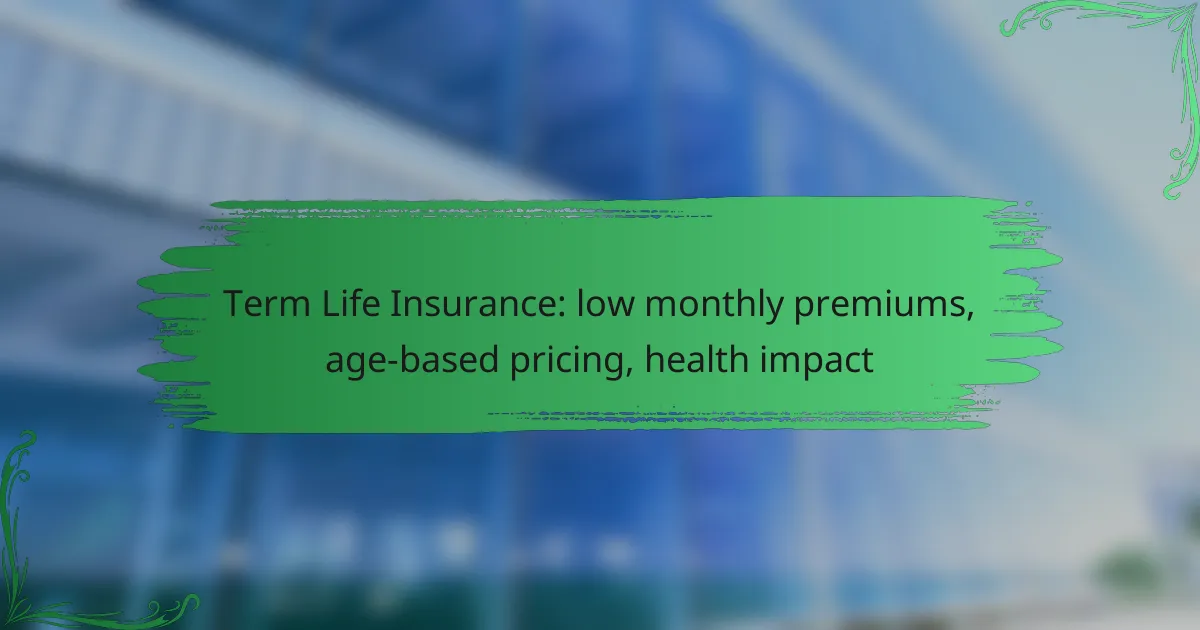Critical illness insurance premiums in the UK can vary widely based on factors such as age, health status, and the desired coverage amount. Younger individuals often benefit from lower rates, while older applicants may face higher premiums due to increased health risks. Additionally, insurers evaluate various health factors, including medical history and lifestyle choices, to determine eligibility and pricing.

What are the premium costs of critical illness insurance in the UK?
The premium costs of critical illness insurance in the UK vary significantly based on several factors, including age, health status, and coverage amount. Generally, premiums can range from low tens of pounds to several hundred pounds per month, depending on individual circumstances.
Average premium costs by age group
Premium costs for critical illness insurance typically increase with age. For instance, individuals in their 20s may pay around £10 to £30 per month, while those in their 40s might see premiums rise to £30 to £80. By the time individuals reach their 50s or 60s, monthly premiums can range from £80 to over £200.
It’s essential to consider that these figures are averages and can vary based on the insurer and specific policy features. Younger applicants often benefit from lower rates, making early enrollment a financially sound decision.
Factors influencing premium rates
Several key factors influence the premium rates for critical illness insurance. Age is the most significant, as older individuals face a higher risk of illness. Health conditions, lifestyle choices such as smoking, and family medical history also play crucial roles in determining premiums.
Additionally, the level of coverage selected impacts costs. Policies that cover a broader range of illnesses or offer higher payout amounts will generally incur higher premiums. It’s advisable to compare different policies and consider both coverage and cost to find the best fit for your needs.

How does age affect critical illness insurance premiums?
Age significantly influences critical illness insurance premiums, with younger individuals typically paying lower rates. As people age, the likelihood of developing health issues increases, leading to higher premiums to reflect this risk.
Premium variations by age bracket
Insurance companies often categorize applicants into age brackets, which can range from under 30 to over 60. For example, individuals in their 20s may pay premiums in the low tens of dollars monthly, while those in their 50s might see rates increase to several hundred dollars. This tiered pricing structure reflects the rising health risks associated with aging.
Many insurers offer discounts for younger applicants or those in good health, making it beneficial to secure coverage early. Delaying the purchase of critical illness insurance can lead to significantly higher costs later on.
Age-related risk factors
As individuals age, they become more susceptible to chronic illnesses such as heart disease, cancer, and diabetes, which are key considerations for insurers. These health risks are factored into premium calculations, often resulting in higher rates for older applicants.
Additionally, lifestyle choices, such as smoking or lack of exercise, can further increase premiums. It’s crucial for applicants to maintain a healthy lifestyle to potentially lower their insurance costs, regardless of age.

What health factors impact critical illness insurance eligibility?
Health factors play a crucial role in determining eligibility for critical illness insurance. Insurers assess various medical conditions, lifestyle choices, and overall health to evaluate risk and set premiums.
Common health conditions affecting coverage
Several health conditions can significantly impact your ability to obtain critical illness insurance. Common issues include heart disease, diabetes, cancer, and respiratory diseases. Insurers often require medical documentation and may impose waiting periods or exclusions for these conditions.
For example, individuals with a history of heart disease may face higher premiums or limited coverage options. It’s essential to disclose all relevant health information during the application process to avoid complications later.
Impact of pre-existing conditions on premiums
Pre-existing conditions can lead to increased premiums or even denial of coverage for critical illness insurance. Insurers typically assess the severity and management of these conditions when calculating rates. Individuals with well-managed conditions may still qualify for coverage, but at a higher cost.
As a rule of thumb, if you have a pre-existing condition, expect premiums to be higher, potentially by 20-50% compared to those without such conditions. It’s advisable to shop around and compare quotes from different providers to find the best options available for your health status.

What are the key considerations when choosing critical illness insurance?
When selecting critical illness insurance, it’s essential to evaluate premium costs, age factors, and health considerations. These elements significantly influence coverage options and overall affordability, impacting your financial security in the event of a serious illness.
Essential coverage features
Key features of critical illness insurance include the types of illnesses covered, the payout structure, and any exclusions. Most policies cover major conditions like cancer, heart attack, and stroke, but it’s crucial to read the fine print to understand what is included or excluded.
Additionally, consider the waiting period before benefits are payable and whether the policy offers a lump-sum payment or ongoing support. A lump-sum payout can provide immediate financial relief, while ongoing support may help with long-term care costs.
Comparing providers in the UK
When comparing critical illness insurance providers in the UK, look for differences in premium costs, coverage limits, and customer service ratings. Premiums can vary widely based on age, health status, and the specific illnesses covered, so obtaining quotes from multiple insurers is advisable.
Check for additional benefits such as wellness programs or the option to convert to a permanent policy. Reading customer reviews and understanding the claims process can also provide insights into which provider may best meet your needs.

How do lifestyle choices influence critical illness insurance?
Lifestyle choices significantly impact critical illness insurance premiums, as insurers assess the risk associated with various habits. Factors such as smoking, alcohol consumption, exercise, and diet can lead to higher premiums or even denial of coverage.
Effects of smoking and alcohol consumption
Smoking and excessive alcohol consumption are major risk factors that insurers consider when determining critical illness insurance premiums. Smokers may face premiums that are significantly higher, often by tens of percent compared to non-smokers. Similarly, individuals who consume alcohol heavily may also see increased costs or restrictions on coverage.
To mitigate these effects, quitting smoking and reducing alcohol intake can lead to lower premiums over time. Insurers typically require a period of abstinence before they will reassess the risk and potentially lower the premium.
Impact of exercise and diet on premiums
Regular exercise and a balanced diet can positively influence critical illness insurance premiums. Individuals who maintain a healthy lifestyle are often viewed as lower risk, which can result in more favorable premium rates. For example, those who exercise regularly may see premiums that are lower by a small percentage compared to sedentary individuals.
To maximize benefits, aim for a consistent exercise routine and a nutritious diet. Insurers may request documentation or evidence of healthy habits, so keeping records of fitness activities and dietary choices can be beneficial when applying for coverage.

What are the trends in critical illness insurance for the future?
Future trends in critical illness insurance are leaning towards more personalized coverage options and the integration of technology for better policy management. Insurers are adapting to changing consumer needs, focusing on flexibility and accessibility.
Emerging coverage options
Insurers are increasingly offering customized critical illness policies that cater to specific health risks and lifestyle choices. For example, some plans may include coverage for conditions like mental health issues or specific cancers that were previously excluded.
Additionally, there is a growing trend towards hybrid policies that combine critical illness coverage with life insurance. This allows policyholders to access benefits for critical illnesses while still ensuring life coverage, providing a more comprehensive safety net.
Impact of technology on policy management
Technology is transforming how policyholders manage their critical illness insurance. Mobile apps and online platforms enable users to easily track their policies, file claims, and access resources related to their coverage.
Moreover, telemedicine is becoming a valuable tool in the claims process, allowing for quicker assessments and approvals. Insurers are also using data analytics to refine risk assessments and tailor policies to individual health profiles, enhancing the overall customer experience.



